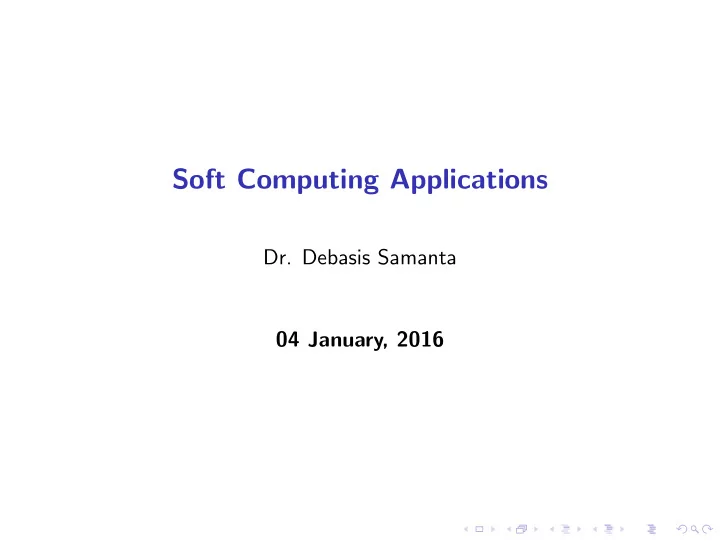

Soft Computing Applications Dr. Debasis Samanta 04 January, 2016
Class Organization Semester : Spring, Session 2015-2016 Course : Soft Computing Applications Code : IT60108 Credit : 4-0-0 = 4 Slot : C Timing : Tuesday 06:00 PM - 08:00 PM : Friday 06:00 PM - 08:00 PM Class Room : SIT Seminar Room
Course Plan 1. Introduction to Soft Computing 2. Evolutionary Computing ◮ Genetic Algorithms (GAs) ◮ Simulated Annealing (SA) ◮ Ant Colony Optimization (ACO) ◮ Particle Swam Optimization (PSO) 3. Fuzzy Logic ◮ Fuzzy Set, Fuzz Logic, Fuzzy Algebra ◮ Fuzzy Reasoning and Fuzzy Classification 4. Artificial Neural Networks (ANNs) ◮ Different ANNs ◮ Learning with ANNs 5. Advanced Topics ◮ Mixed(Hybrid) Soft Computing ◮ FL-GA, FL-ANN, GA-ANN, FL-GA-ANN ◮ Hidden Markov Modeling (HMM) ◮ Support Vector Machine (SVM)
Reference I Books: 1. Evolutionary Computing : A Unified Approach K. A. De Jong (Prentice Hall Inc, USA) 2009 2. Evolutionary Algorithm for Solving Multi-objective Optimization Problems (2 nd Edition) Collelo, Lament, Veldhnizer ( Spring, 2010) 3. An Introduction to Genetic Algorithm Melanic Mitchell (MITPress, 2000) 4. Fuzzy Logic : A Practical Approach F. Martin, Mc Neill and Ellen Thro (A P Professional, 2000) 5. Fuzzy Logic with Engineering Applications Timothy J. Ross (Wiley, 2015)
Reference II 6. Foundation of Neural Network, Fuzzy Systems & Knowledge Engineering by Nikole K Kashov (MIT Press, 1998) 7. Neural Networks and Learning Machines Simon Haykin (PHI, 2006) 8. Neural Network, Fuzzy Logic and Genetic Algorithm : Synthesis and Applications S. Rajasekaran and G. A. Vijayalakshmi Pai (Prentice Hall India, 2010) 9. Soft Computing : Fundamentals and Applications (2nd Ed.) D. K. Pratihar (Narosa, 2013) For lecture slides and other supporting materials, please visit the course web page at ”www.nid.iitkgp.ernet.in / DSamanta / ”
Evaluation Plan 1. Mid-Semester Test : 30% Syllabus: Fuzzy Logic and Artificial Neural Network 2. End-Semester Test : 50% Syllabus: 20 % from the syllabus covered till Mid-semester. 80 % from the syllabus covered post Mid-semester. 3. Teacher’s Assessment : 20% ◮ Class Test 1 : 05% (Topic: Fuzzy Logic) ◮ Class Test 2 : 05% (Topic: Artificial Neural Network ) ◮ Class Test 3 : 05% (Topic: Evolutionary Computing Techniques) ◮ Practical problem solving: 05% (Topic: Advanced Topics) Announcement: One week notice period. Please keep on watching the **Noticeboard** of the course web page.
Course Website www.nid.iitkgp.ernet.in / DSamanta / Email : debasis.samanta.iitkgp@gmail.com Please use the subject line as: IT60108: Spring 2015-2016 Teaching Assistants: 1. Mr. Gaurang Panchal, Research Scholar gp.citc@gmail.com 2. Major Atul Nayyar atul.swat@gmail.com 3. Major Priyotosh M. Will be announced later
Today’s Topics Introduction to Soft Computing ◮ Concept of computing ◮ Important characteristics of ”Computing” ◮ Soft computing vs. ” Hard ” Computing ◮ Few examples of Soft computing applications ◮ Characteristics of Soft computing ◮ Hybrid computing
Concept of Computing Figure : Basic of computing y = f ( x ), f is a mapping function f is also called a formal method or an algorithm to solve a problem.
Important Characteristics 1. Should provide precise solution. 2. Control action should be unambiguous and accurate. 3. Suitable for problem, which is easy to model mathematically.
Hard Computing In 1996, LA Zade (LAZ) introduced the term hard computing. According to LAZ: We term a computing as ”Hard” computing, if ◮ Precise result is guaranteed ◮ Control action is unambiguous ◮ Control action is formally defined (i.e. with mathematical model Example: ◮ Solving numerical problems (e.g. Roots of polynomials, Integration etc.) ◮ Searching and sorting techniques ◮ Solving ”Computational Geometry” problems (e.g. Shortest tour in Graph theory, Finding closest pair of points etc.)
Problems in some other areas of applications ◮ Medical diagnosis ◮ Person identification / Computer vision ◮ Hand written character recognition ◮ Pattern recognition and Machine Intelligence MI ◮ Weather forecasting ◮ VLSI design ◮ Network optimization
Characteristics of Soft Computing ◮ It does not require any mathematical modeling of problem solving ◮ It may not yield the precise solution ◮ Algorithms are adaptive (i.e. it can adjust to the change of dynamic environment) ◮ Use some biological inspired methodologies such as genetics, evolution, Ant’s behaviors, particles swarming, human nervous systems etc.
Hybrid Computing It is a combination of the conventional hard computing and emerging soft computing Figure : Concept of Hybrid Computing
Problems to ponder ◮ Hard computing (HC) vs. Soft computing (SC) ◮ Limitation(s) in HC and SC ◮ Examples of ( only ) Hard computing and ( only ) Soft computing ◮ Examples of Hybrid computing
Any Questions??
Recommend
More recommend